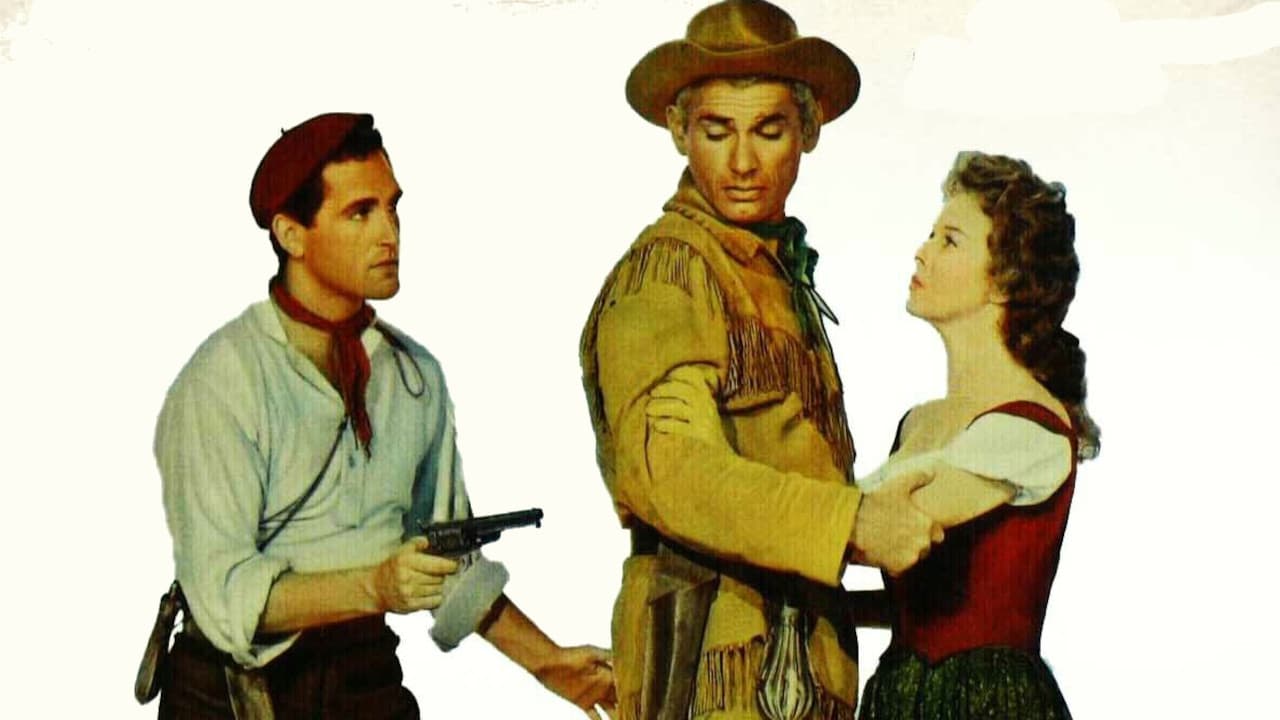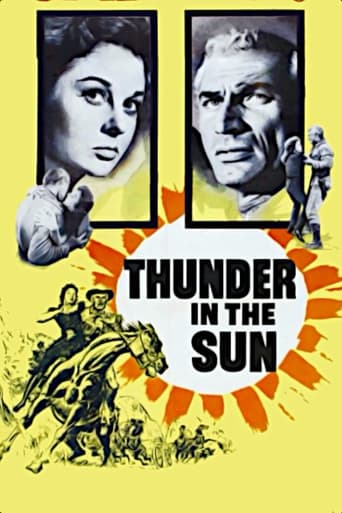davidjanuzbrown
This is a movie that I like more then most people. I am not of Basque Heritage, so I cannot say what they did wrong as far as a culture and language is concerned. But if you watch the movie you will see that it is the Basque Settlers ( who needed to plant grape vines they brought from France) as opposed to the American trail guide, Lon ( Jeff Chandler) that comes up with the plan to defeat the Indians. The best one in the movie is Gabrielle Dauphin ( Susan Hayward) who is in a loveless, arraigned marriage to Andre. She is the walking definition of a spitfire, which you see in her flamingo dance and the settlers want to quit and she keeps them going, and when she pulls a gun on Lon and he knows she will use it. Andre simply cannot handle her ( even his mother calls him old). Andre is eventually killed by accident, but by tradition his younger brother Pepe must marry her. Of course, the one she really loves is Lon. Spoilers ahead: The way the Basque and Lon take to the mountains and defeat the Indians is something to watch. At the end Lon finds the perfect spot to plant the vines, which he shows to Gabrielle and Pepe, and Pepe sees the love that they have for each other. Pepe said to Lon " The best way to marry is for love." and he lets him have her. 9/10 Stars mostly for Hayward who dominates every scene she is in.
weezeralfalfa
The theme rather reminds me of the HMS Bounty, in which water rations for the crew were minimal, so that fresh water on the ship could mostly be used to keep the breadfruit seedlings alive during the long voyage from Tahiti to Jamaica. In this case, fresh water in the desert portion of the journey is scarce, thus Chandler's wagon master character (Lon) wants the Basques to pitch their cherished grape vines so that the livestock and people have enough to survive. Even though some of the horses die of thirst, the Basques refuse to give up their vines, most vocally by Susan Hayward's character(Gabrielle).Hollywood films of this era usually played loose with historical and geographical accuracy, but this one is especially bizarre. The Basques are from the French side of the Pyrenees, and claim they left their homeland in the wake of post-Napoleonic unrest, one claiming he fought with Napoleon. Lon claims he fought with Washington in the Revolutionary War. Yet, this is supposed to be 1847(or 1850?)!. Historically, it's true that many Basques, especially on the French side, emigrated after the conclusion of the Napoleonic Wars, and that their economy was then in bad shape.Strange that Basques are characterized as introducing grapes(or at least their favorite cultivar) to California. Historically, it was the Spanish missions that established the early plantings in CA, Basques most commonly initially serving as sheepherders in the American West. I was unable to find evidence in support of the supposed Basque customs emphasized in the film of keeping the hearth pot burning perpetually, nor childhood betrothal. Also, the Spanish Flamingo dance near the beginning apparently isn't a Basque trait. The striking ululations made by the men on several occasions apparently are a Basque feature, but are not used for long distance communication nor for war whoops, as featured. Jacques Bergerac, who played Pepe, the brother of Gabrielle's husband, grew up in then Pyrenees region, although I don't know if he was a Basque. The screenplay includes some common features of wagon train films. Of course, there's a confrontation with Native Americans, rather late, not far from their destination. It was staged in the unique Alabama Hills, near Lone Pine and Mt. Whitney, were many a western was partially shot. In fact, most of the film was shot in various locations around Lone Pine, including the Olancha sand dunes,to the south. The prairie fire segment is rather reminiscent of that in "The Texans", filmed 2 decades earlier, except that they had to fight the fire and the Native Americans simultaneously in that one.Like "Westward the Women", when the wagons encounter a stretch of sand it must cross, the wagon master orders all heavy, not absolutely essential, items to be tossed. Historically, this most commonly occurred just before crossing the Rockies, with the fear that the pulling team would otherwise be reduced to a slow crawl up steep slopes. Also, as in "Westward the Women", and, no doubt, some other wagon train sagas, the footloose wagon master is tamed by a beautiful and forceful young woman(Gabrielle in this case) in the train. Presumably, she believes that this hard drinking. womanizing, loner can be made to be satisfied with a sedentary life. But, we Never find out if this works out. However, unlike Taylor's character in the former film, it's Lon who is doing the pursuing of very reluctant Gabrielle, who is married, and then promised by tradition to the brother of her deceased husband(Pepe), when her husband is accidentally shot. Although Lon and Pepe are then enemies during the latter part of the journey, Pepe finally give into Lon when they reach their 'promised land', with the excuse that old customs can be discarded in their new land. Actually, Lon is obnoxiously arrogant when it comes to his self appraisal of his desirability as a lover or husband vs. Gabrielle's husband or Pepe.
bkoganbing
The filming of Thunder In The Sun probably had its start years before they were movie stars with two grade school kids named Edythe Marrenner and Ira Grossel who both went to Hollywood and became Susan Hayward and Jeff Chandler. These two were really good friends going back to their childhoods in Brooklyn. So when Susan Hayward reached the top of her career with her Oscar for I Want To Live, I'm sure she wanted to make a film with Chandler. It's a pity these two couldn't have found a better one.It's an unusual subject for a western, a wagon train of Basque immigrants from the French Pyrennees who are going to California to start their own wineries. Their most precious cargo is the vines carrying the grape seeds that have to be watered. Of course on the desert, man and animals also have to be watered. That leads to the usual situations in westerns like these.Chandler is not your usual western hero either. He takes his pleasures where he finds them be it women or drink. Hayward has been wed to Carl Esmond the leader of the group and when he's killed by an overanxious sentry, the younger brother Jacques Bergerac is ready to take his place. And Hayward is also guarded by her formidable mother-in-law, Blanche Yurka.Though the folks have unusual clothing for wagon train travelers, the story does have the usual wagon train situations found in westerns, climaxed by a nicely staged fight with Indians. As Bergerac says, the Indians have never faced Basques before and these people are born mountain fighters.In two years Jeff Chandler would be gone and he never did to make another film with his good childhood friend Susan Hayward. That's a pity.
frankfob
Very odd western about a wagon train of Basque immigrants making its way through Indian territory with a cargo of special vines so they can start a vineyard in the "new world." About the only ones who are even remotely convincing as Basques are Italian actor Fortunio Bonanova and French actor Jacques Bergerac--another oddity, since while there are some French Basques (the vast majority come from Spain), there are none in Italy. Nothing much really happens until near the end of the picture, when the Basques fight off an Indian attack with their bizarre method of bouncing off of rocks and boulders like mountain goats while emitting screams that seem to be a combination of a "Rebel yell" and hog calling. It confuses the hell out of the Indians (not to mention the audience). If you've ever had an urge to see a Basque western, this is the movie for you. If the sight of overweight, middle-aged guys dressed in white shirts and berets trampolining off of boulders the size of Buicks interests you, this is your movie. Otherwise, don't bother.

